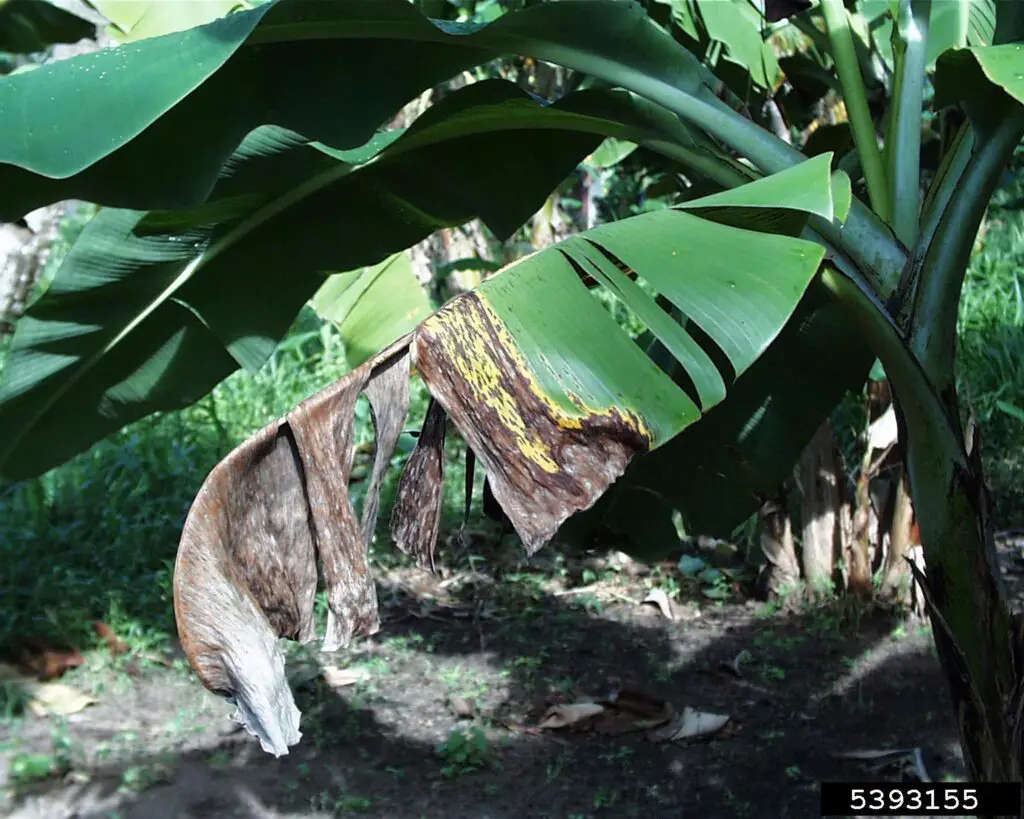Banana plants are susceptible to a variety of pests and diseases that can cause problems. Some of the most common culprits include aphids, banana weevils, scale insects, mealybugs, and nematodes. In addition to these insect pests, fungal diseases like Panama disease or black Sigatoka can also cause damage to the plant.
Damage from these pests and diseases may manifest as yellowing or browning leaves, wilting of foliage or stems, premature ripening of fruit, stunted growth or leaf spots. Proper diagnosis is necessary in order to identify the source of your problem so you can take appropriate action such as applying pesticides or fungicides if needed.
If you recently planted a banana plant in your home and noticed that it’s not thriving, it could be due to pests. Pests such as aphids, mites, borers and scale can all cause damage to the leaves of your banana plant by feeding on them or laying eggs on them. If left untreated, these pests can eventually kill the entire plant.
To protect your banana plants from these pesky creatures, use organic pesticides and inspect plants regularly for signs of infestation.

Credit: www.reddit.com
How Do You Protect Banana Trees from Pests?
Banana trees are highly susceptible to pests and diseases, which can cause significant damage to their yield. The best way to protect banana trees from pests is by using integrated pest management (IPM) strategies. This involves a combination of cultural practices like proper plant spacing, pruning and mulching; biological controls such as natural predators or parasites; chemical treatments when necessary; and monitoring for signs of infestation or disease.
Cultural practices help create an environment that promotes banana tree health while reducing the number of insects on the foliage. Biological controls involve introducing beneficial insects into the area that feed on destructive pests like aphids, mites and thrips. Chemical treatments should be used only after monitoring has revealed evidence of a pest outbreak — never as a preventative measure — because they have potential negative impacts on other beneficial insects in the area.
Finally, regular monitoring helps identify any problems before they become serious enough to warrant treatment so you can stay ahead of any lingering threats facing your banana trees!
How Do I Get Rid of Bugs on My Banana Plant?
Getting rid of bugs on your banana plant can be a tricky task, but with some patience and the right methods, it can be done. Start by inspecting the leaves for signs of bugs or eggs. If you’re seeing small specks on the leaves, these are likely eggs that need to be removed before they hatch into full-sized insects.
Use a damp cloth to gently remove any bugs or eggs you find from the plant’s leaves. Next, mix up an insecticidal soap solution and spray it onto all parts of the banana tree where you found insects or evidence of infestation. This should help to eliminate most common pests like aphids and mealybugs quickly and easily.
Finally, make sure that you’re keeping your banana tree as healthy as possible by providing adequate water and nutrients throughout its growing season so that it has enough energy to fight off potential pests itself!
What is the Common Problem in Banana Plant?
One of the most common problems in banana plants is nematodes. Nematodes are microscopic worms that live in the soil and feed on plant roots, causing damage to the plant and reducing yield. Additionally, nematode infestations can reduce a plants ability to uptake necessary nutrients from the soil leading to stunted growth and poor fruit production.
Other pests such as aphids, thrips, mites, whiteflies and mealybugs also present problems for banana plants by sucking sap from foliage or spreading diseases among populations of otherwise healthy bananas. Fungal disease such as Panama Disease is another major problem for banana growers worldwide as it attacks both the foliage of a plant and its root system making it difficult if not impossible to control or eradicate effectively with fungicides alone. Finally, environmental factors like excessive heat or cold can cause significant stress to banana trees resulting in yellowing leaves which may be indicative of an underlying nutrient deficiency or other health issue that needs addressing before long-term harm occurs.
How Do You Protect Banana Plants?
Bananas are a popular fruit all over the world, but in order to keep them growing healthy and productive for years, it is important to protect banana plants from disease and pests. The best way to protect your banana plants is by practicing good cultural practices such as proper pruning and fertilization as well as providing adequate water. Additionally, you can also use pest control methods such as mulching or spraying with insecticides when needed.
It’s also important to inspect your plants regularly for signs of disease or infestation so that any issues can be addressed early on before they become too severe. Finally, make sure that you provide adequate protection against extreme weather conditions such as strong winds or heavy rain which may damage the plant’s leaves and stems. By following these steps, you can ensure that your banana plants stay protected throughout their life cycle!
PLEASE TELL ME! What is this pest eating my banana leaves?
What is Eating My Banana Tree Leaves
Banana trees are prone to a few common problems that can cause the leaves to be eaten away, such as banana aphids and banana weevils. These pests feed on the sap of the tree, leaving behind small holes in the leaves or completely eating them away. In addition to these two insects, spider mites may also attack your banana tree and cause damage to its foliage.
If you notice that your banana trees’ leaves are being eaten by an insect infestation, it’s important to take immediate action in order to protect your plant from further damage.
What’S Wrong With My Banana Tree
Banana trees are very sensitive to cold temperatures and can suffer frostbite if exposed to anything below 59°F. Without proper care and protection, your banana tree may develop a variety of issues such as yellowing leaves, wilting stems, stunted growth or even death. Other common problems include pest infestation, over-fertilization or inadequate nutrition leading to nutrient deficiencies.
To ensure optimal health of your banana tree it is important that you provide adequate water and nutrients while also protecting it from extreme weather conditions.
White Bugs on Banana Plant
White bugs on a banana plant are likely mealybugs which are small, oval-shaped insects that feed on the sap of plants. Mealybugs can cause yellowing and wilting of leaves, as well as stunted growth in severe infestations. To control mealybug populations, it is important to identify and treat affected areas with insecticides or natural solutions such as rubbing alcohol or neem oil.
Indoor Banana Plant Bugs
Banana plants are susceptible to a variety of indoor pests, including mealybugs, scale insects and spider mites. These bugs feed on the sap from the leaves and stems of banana plants, leading to yellowing or brown spots on the foliage as well as stunted growth. To get rid of them, use rubbing alcohol-soaked cotton balls to remove any visible bugs and their eggs.
Insecticidal soaps can also be used for more severe infestations.
Best Fungicide for Banana Plants
Banana plants are susceptible to a variety of fungal diseases, so it is important to use a fungicide in order to keep them healthy. One of the best fungicides for banana plants is chlorothalonil, as it has been proven effective against several major fungal diseases. It should be applied at regular intervals throughout the growing season in order to ensure that the plant remains protected from disease.
Banana Plant Diseases And Treatment
Banana plants are prone to many diseases, including Fusarium wilt, Panama disease, black leaf streak disease and Sigatoka. To treat these diseases it is important to use fungicides and insecticides when necessary. In addition to this, proper irrigation and crop rotation can help prevent the spread of disease.
It is also important to avoid overcrowding banana plants as this restricts air flow which in turn encourages the spread of pathogens from one plant to another.
How to Get Rid of Banana Weevils
Banana weevils are a common pest that can infest stored bananas and other fruits. To get rid of banana weevils, it is important to inspect any fruit you purchase for signs of the pests, such as small holes in the skin or eggs on the surface. If any infested fruit is found, discard it immediately and keep all other fruits away from it.
Additionally, make sure to thoroughly clean out pantries and cupboards regularly with soapy water to remove any remaining eggs or larvae. Finally, store your fresh produce in airtight containers or bags to prevent further infestation.
Conclusion
In conclusion, it is important to keep an eye on your banana plants and make sure that you take action if you notice anything strange or out of the ordinary. There are a variety of pests and diseases that can cause harm to banana plants if left untreated, so it is essential to be vigilant in monitoring your plant’s health. If you think there could be something eating away at your banana plant, contact a local gardening expert for help in identifying the problem and taking appropriate measures to protect your plant.


